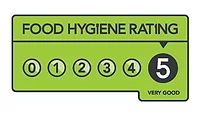UK Business Displays of Food Hygiene Rating Scheme Scores Continue to Increase

Image credit: Shvets Anna via Pexels
In 2022, two-thirds of business in England and nine of ten businesses in Northern Ireland and Wales had their food hygiene ratings on visible display, according to an audit by the UK Food Safety Authority (FSA). Businesses that did not visibly display their ratings attributed the decision to a range of reasons, including having nowhere suitable to show the sticker and having never received a sticker.
Under the UK Food Hygiene Rating Scheme (FHRS), places where food is supplied, sold, or consumed are given a rating ranging from 0 to 5, with 5 indicating “very good” food hygiene and 0 indicating “urgent improvement necessary.” In Wales and Northern Ireland, businesses have been legally required to display their food hygiene rating sticker in a prominent place like the front door, entrance, or window of the business since 2013 and 2016 respectively. Businesses in England do not have to display their rating at their premises but are encouraged to do so. Across England, Northern Ireland, and Wales, food hygiene ratings are also available to search on the FSA FHRS website.
FSA has conducted research into the display of FHRS scores in England, Northern Ireland, and Wales since 2011, with a pause in 2020 due to COVID-19. As with the previous waves of the research, the objectives were to:
- Provide a representative estimate of the display of food hygiene ratings by food businesses
- Explore the reasons and drivers for display and non-display
- Explore business awareness and attitudes towards FHRS.
Fieldwork in October and December 2022 comprised 1,525 covert audits of food businesses in England, Northern Ireland, and Wales (501, 527, and 497 respectively), and 1,500 telephone interviews of food businesses in England, Northern Ireland, and Wales (500 per nation). In total, 484 food businesses that participated in the telephone survey were also audited.
In England, around two-thirds (67 percent) of businesses were displaying a food hygiene rating, either inside or in a location visible from outside their premises. Although not significantly higher than in 2021 (64 percent), the finding represents a continuation of the steady upwards trend in rates of display by businesses in England since 2017, when 55 percent of businesses displayed a sticker. There has also been an increase since 2019 in the proportion of businesses displaying the sticker so that it is visible from the outside of their premises (63 percent in 2022 compared to 55 percent in 2019).
In Northern Ireland and Wales, where it is mandatory for businesses to display their food hygiene rating, the vast majority of businesses had their rating on display either inside or in a location visible from outside the premises (Northern Ireland 87 percent and Wales 91 percent). In both countries these figures represented a return to pre-pandemic levels of display following a slight dip in 2021 (84 percent and 88 percent, respectively). However, approximately one in ten businesses in Northern Ireland and Wales are not displaying FHRS scores in a compliant fashion. In the survey, businesses in Northern Ireland and Wales commonly reported that they did not display their rating because there was nowhere suitable to show it outdoors.
In England and Northern Ireland, takeout restaurants and sandwich shops were more likely than average to have a sticker on display (England 79 percent and Northern Ireland 95 percent), while accommodation businesses, pubs, bars, and nightclubs were less likely (England 57 percent and Northern Ireland 67 percent). In Wales, restaurants and catering businesses were more likely than average to display their sticker (96 percent), while retail businesses like supermarkets were less likely (81 percent).
Due to the statutory requirement to display, there was little difference in display rates between businesses with different food hygiene ratings in Northern Ireland and Wales. However, in England, businesses with a rating of 5 were more likely than average to display a sticker (77 percent), while those with a rating of 4 (43 percent) or 3 (39 percent) were less likely. Furthermore, focusing on audited food businesses with a rating of less than 3, it was much more common for businesses in Northern Ireland (four out of six) and Wales (17 out of 20) to have an FHRS sticker on display than their counterparts in England (six out of 22).
Looking for quick answers on food safety topics?
Try Ask FSM, our new smart AI search tool.
Ask FSM →
Alongside an audit of the business premises, auditors conducted an online review to see whether the food hygiene rating was displayed on the business’s website or Facebook Business Page (regardless of whether the business offered online sales). Most businesses had an online presence (England 84 percent, Northern Ireland 89 percent, and Wales 87 percent), however, relatively few businesses with a website or Facebook Business Page displayed their rating on these platforms (13 percent in England, 6 percent in Northern Ireland, and 8 percent in Wales). Where displayed, ratings usually matched the rating shown on the FHRS database (95 percent in England, 100 percent in Northern Ireland, and 92 percent in Wales).
Businesses in England that did not display their FHRS sticker or who did not display it in a visible place for customers, gave a range of unprompted reasons why this was the case. The most common reasons given were there being nowhere suitable to show it outdoors (30 percent), ratings being displayed inside the premises (11 percent), and having never received a sticker (11 percent).
FSA found strong support for mandatory FHRS score display, with around nine in ten businesses in Northern Ireland and Wales saying that the legal requirement to display the rating is a good thing (Northern Ireland 91 percent, Wales 89 percent). Support for introducing mandatory display was also high in England with 82 percent of businesses reporting they believed it would be a good thing.
Businesses were asked if they knew they could appeal their rating, request a re-rating inspection, and have a “right to reply” if they were unhappy with their FHRS rating. In line with 2021, overall self-reported awareness was high, with more than three-quarters aware of each option in England (76 percent for appeal, 77 percent for “right to reply,” and 79 percent for re-rating). Closer to nine in ten businesses were aware in Northern Ireland (87 percent for appeal, “right to reply,” re-rating) and Wales (89 percent for appeal and “right to reply,” and 91 percent for re-rating).
Most businesses reported being incentivized to maintain or improve their food hygiene rating and consider that the display of their rating has a range of positive impacts on customer perceptions of the business. Nearly 100 percent of food businesses agreed that they work hard to maintain or improve their food hygiene rating and that displaying a food hygiene rating proves to consumers that the business takes food hygiene seriously.








